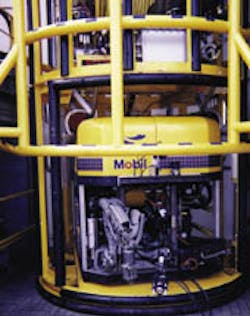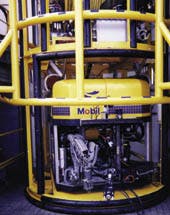Designing an ROV for ultra-deepwater, rough seas
Combatting contra-currents and "strumming"
The Clansman ROV is being designed to pursue drilling water depths up to 9,800 ft, and mineral recovery operations to 19,700 ft.The Clansman is the name of a powerful, high specification work class remotely operated vehicle (ROV) installed on the mobile offshore drilling unit Jack Bates, which can operate in water depths up to 5,400 ft. The rig began drilling in the Atlantic Ocean west of Britain for Mobil in May of this year.
The ROV unit was designed by SubSea Offshore Limited. The ROV's specification was to match the rig's operations in all conditions. In addition to the 5,400 ft depth capability, the Jack Bates also can operate in winds up to 74 knots and waves up to 10 meters high.
As part of their ongoing exploration and development plan, Mobil is undertaking exploration drilling in several tran ches of West of Britain acreage, one of the most demanding and hostile offshore environments in the world. Water depths range between 3,300 ft and 5,300 ft. This is three times the depth of the nearby Foinaven field, which is currently the deepest development in British waters.
Tough conditions
There are strong, complex surface and underwater currents running in these deepwater areas, where the cold water coming down from the Arctic meets the warmer waters of the Gulf Stream. These currents can run in opposite directions at different depths, creating a new set of problems when operating ROV's and deploying equipment to the seabed.The Jack Bates is one of the largest rigs in the world and has been contracted by Mobil to perform exploration drilling in this area. Mobil has sought to maximize the availability of the ROV because of the reported high costs of the drilling unit.
Following consultation with Mobil, SubSea identified the following key requirements for the project:
- The ROV system had to be made safe to operate in all environments that the rig could operate in, with a high standard of engineering.
- Mobil preferred that the design, engineering, and building of the ROV
- system was done in Europe.
- The ROV System had to be installed and operational within a nine month period from the project start date.
- A high percentage of reliability was a major requirement due to the rig running costs. Any ROV downtime can suspend operations and as a result have significant cost implications to the project.
Critical factors
From these requirements emerged the following critical factors which SubSea believed to be of prime importance in ensuring the success of the project and the satisfaction of Mobil:- The system needed to be highly reliable in order to minimize breakdowns, thus keeping operational costs to a minimum.
- A high speed ROV winch system was paramount in order that transit times to and from the seabed would be minimal. Unproductive time in transit is time wasted for the rig.
- The ROV had to withstand and be able to work at depth in high currents. Failure to do so would have prevented the ROV reaching the work site.
- The ROV was needed to go to depths of 6,500 ft in extreme conditions as the Jack Bates has the capacity to be upgraded to work in this water depth.
Need for quality tools
A number of quality tools were employed by SubSea for the project:- A Fishbone diagram was used to highlight the key requirements and form the critical success factors needed to design the Clansman ROV system.
- The use of this tool focused the project team on producing an ROV system that would exceed Mobil's specifications for the job.
- The failure defect design improvement (FDDI) was first introduced by SubSea in 1996 and now covers all of SubSea's ROV operations. The objective of FDDI is to gather detailed technical data regarding all failure and defects that occur on SubSea's ROV systems.
Mobil provided SubSea with data on deepwater currents in the drilling locations for the West of Britain program. The data was used in the 3D umbilical tracking program (UMTRAC) which, amongst other things, takes into account strumming (vortex induced vibration) of the umbilical to provide accurate forecasts of the ROV's position at depth.
This type of analysis gave the Clansman team a quantitative tool used to specify tether length, vehicle thrust, cable weight and diameter, garage size and weight to meet the specification set by Mobil.
Sustained results
The Clansman ROV system was installed on the Jack Bates ahead of schedule. The completely new ROV was designed, engineered, built, and installed in less than nine months. The ROV was certified by American certifying authorities - ABS.Thus far, the most significant indicator of the Clansman ROV's performance has been its sustained level of reliability. Since being installed, no rig downtime was attributed to the ROV system.
Standard ROV winches operate at speeds of 100 ft/min. The first location of Clansman's operations was at a water depth of 2,600 ft. It would have taken a conventional system around 30 minutes to descend to the work site and 30 minutes to return to the surface.
Since the Clansman system can operate at up to 475 ft/min, it was able to get to the work site less than six minutes after leaving the surface. When the rig moves to locations where the water is 5,300 ft, the savings will be proportionately greater.
To date, the Clansman ROV System has worked at a number of different locations in a variety of weather conditions with great success, including launch and recovery in 8-meter high waves.
Summary
As the industry has developed, de facto milestone depths have come and gone. A water depth of 600 ft was sufficient for ROV performance in the the central and southern North Sea at one time. A depth of 3,300 ft was, until recently, sufficient for the deeper Norwegian sector.Currently, a depth of 6,500 ft is sufficient for the Atlantic Frontier area. SubSea has im proved on the original Clansman design to develop vehicles for 9,800 ft and recently completed a project to design and build an ROV rated to 16,400 ft operating depths.
The next target depth will be 19,700 ft where 95% of the world's oceans become accessible and the potential for mineral recovery is immense. The design, construction and installation of the SubSea/Mobil Clansman ROV system on the Jack Bates is proof that such technological challenges can be achieved.
Copyright 1998 Oil & Gas Journal. All Rights Reserved.

